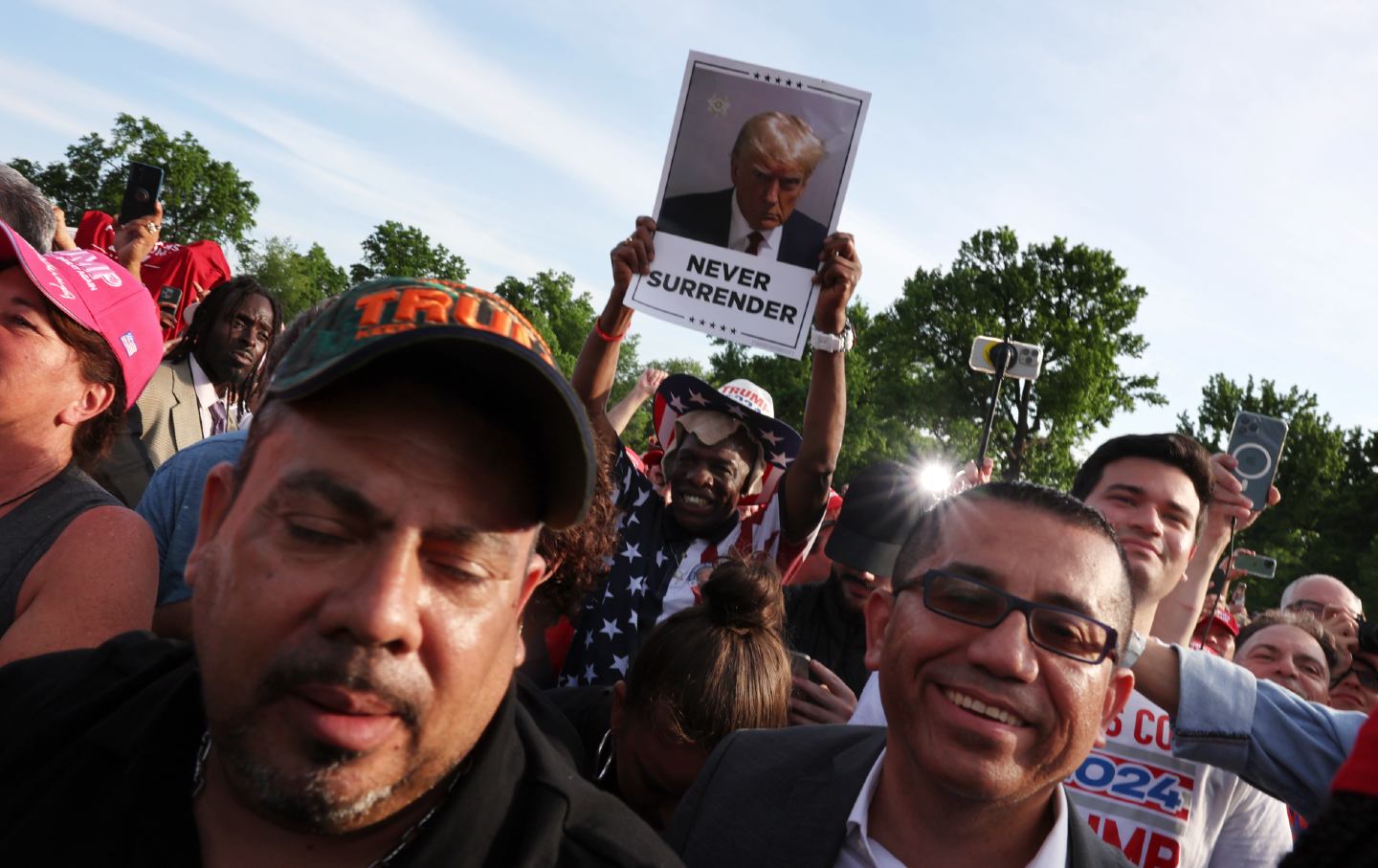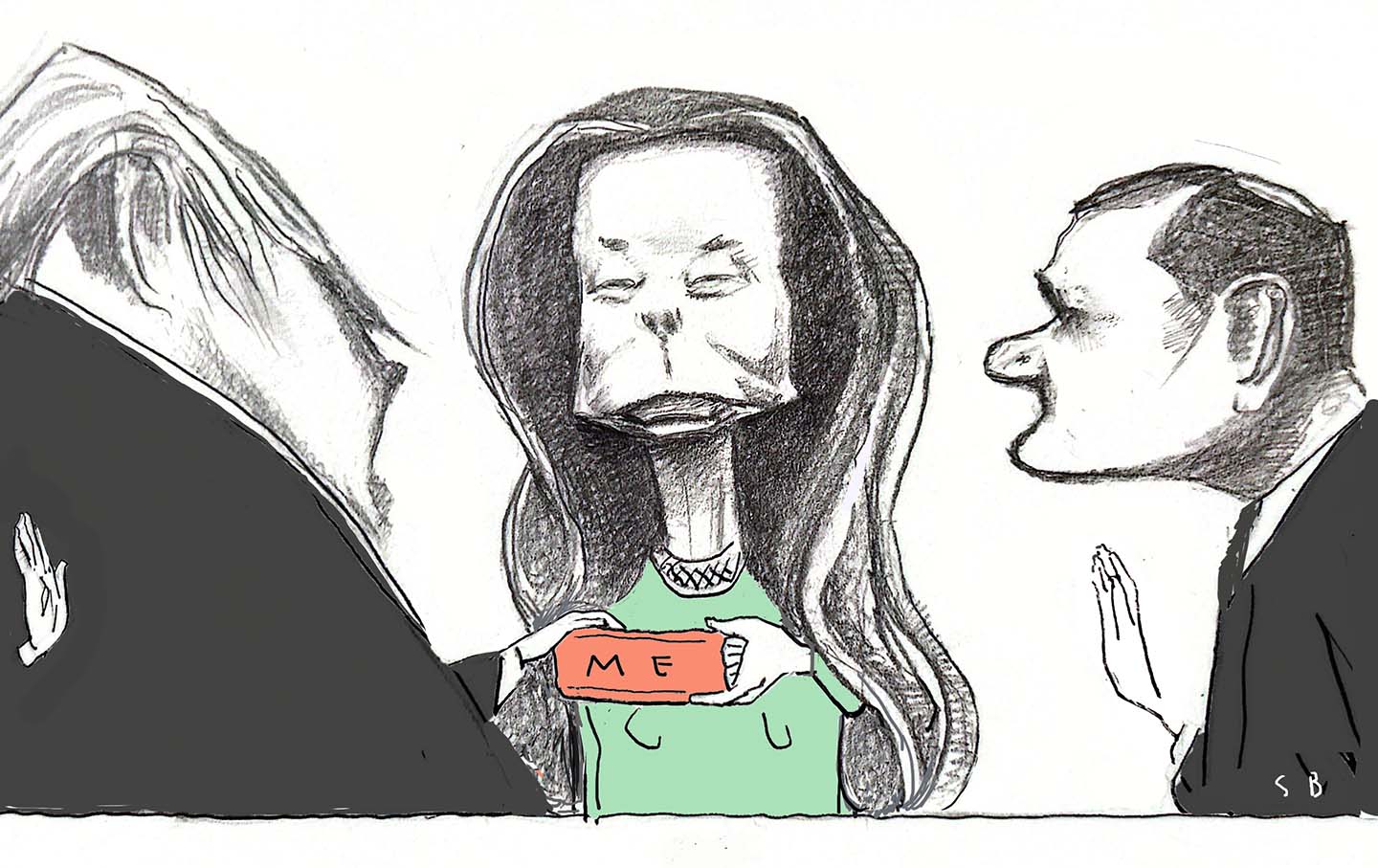Trump Takes the Bronx
45 who wants to be 47 got what he came for.

Supporters of former president Donald Trump watch as he holds a rally in the South Bronx on May 23, 2024, in New York City. The Bronx, home to a large Latino community, has been a Democratic base for generations of voters and the rally comes as Trump looks to attract more non-white voters.
(Spencer Platt / Getty Images)Crotona Park, NY—The Donald was always more of a Queens guy. Even the two years he put in at Fordham’s Rose Hill campus here in the Bronx—before a family connection got him admitted as a transfer to the University of Pennsylvania—left little mark on either the student or the institution. No Trump Memorial Athletic Center to commemorate his time on the squash courts. No Trump Library. Not even a Trump Miniature Golf Course.
So it was a surprising, unexpectedly savvy move to make the most of his court-imposed sequestration in New York City by holding a rally amid the 125 verdant acres of this city park in the South Bronx. Like Newton, Iowa, (the former home of Maytag, where I caught a Trump rally in late 2015), or Monessen, Pennsylvania, (the hollowed-out former steel town where Trump gave a remarkably cogent speech pointing out the damage Bill Clinton’s North American Free Trade Agreement had inflicted on the American working class ), Crotona Park and Morrisania to the south are places Democrats running for president just don’t go anymore.
“This is so amazing,” said the young Black mother bustling her two sons up the hill that runs past the algae-clogged waters of the park’s Indian Lake (name apparently untouched by the tides of reform) to where Trump was speaking. They don’t get a lot of celebrities here. And they haven’t seen a presidential candidate since Bill Clinton in 1997. But back then, Clinton was following in the footsteps of Jimmy Carter (1977), Ronald Reagan (1980), and Jesse Jackson (1984)—though the Rev. Jackson at least spent the night in the neighborhood, as The New York Times put it “to draw attention to the plight of the poor.”
Trump had a different agenda, but the area’s history as a political prop—and the long legacy of broken promises from City Hall, Albany, and Washington—meant the candidate’s message of bad times found a receptive audience.
“They tell you just because we’re surviving, we’re doing OK,” a woman with a red MAGA hat over braided hair extensions down to her waist told me. Like nearly everyone I spoke with in the crowd, she was not eager to see her name in the media. “When you’re financially OK, you’re distracted. Maybe you don’t see what’s going on. But we’re not OK. And we’re paying attention.”
One might well wish to argue with her worldview or her premises. But it would be a mistake beyond mere condescension to dismiss people like her as low-information voters. People know when their lives are a struggle. And while “You’ve Never Had It So Good” might have been a winning slogan for Harold Macmillan in 1950s Britain, telling people that in Joe Biden’s America—where the Dow is at record highs but so are rents, where jobs are precarious, and where healthcare costs mean that bankruptcy, not prosperity, is what’s more likely to be around the corner for many people—just makes people feel like they’re being gaslighted.
Nobody seemed to have an accurate count of the crowd. Word was that the campaign had applied for a permit for 3,500 people. The crowd was considerably smaller than the one I recalled from a Bernie Sanders rally—where he was joined by a Representative Alexandria Ocasio-Cortez—at Queensbridge Park in 2019. Although I’d registered for a ticket, tight security—and the kind of intelligent advance work that knows video of a crowd lining up to see the candidate is even better than footage of a slightly bigger audience—meant I never got close enough to actually see Trump. Still, it was obviously a big pro-Trump gathering—far outnumbering the few hundred counterdemonstrators. And at least as diverse as any Sanders rally I’d attended.
Besides, you could hear him all over the park: “African Americans are getting slaughtered. Hispanic Americans are getting slaughtered. And these millions and millions of people that are coming into our country.… the biggest negative impact is against our Black population, and our Hispanic population, who are losing their jobs, losing their housing, losing everything they can lose.”
When a 20-something Biden supporter from New Jersey took exception to the violence of Trump’s language, the rebuttal came quickly. “He has to be forceful, speak from a position of strength, with authority,” said Michael, who described immigration as his “number-one issue.”
“Things are really bad—with the economy. Immigrants. Education,” Michael told me. “Trump is the right man for the job right now.” Detecting an accent, I asked him where he was from. “Haiti,” he replied. “But when I came here in 1965, this was a different country. There has been some progress—particularly on racism. But the country is heading down.”
Generalizing from a handful of interviews in a crowd of thousands is hardly sound statistically or journalistically. But if there was any common thread to the responses I got to a standard query about what brought them to the rally, it was this narrative of decline. That or a sense that somehow things had been better four years ago—a time when refrigerator trucks sat outside New York’s hospitals waiting for the Covid dead, and the economy fell off a cliff.
“We didn’t have any wars when he was president,” an older Dominican man, who also didn’t want to give his name, told me. “Whatever his form of diplomacy was, it was working.”
Popular
“swipe left below to view more authors”Swipe →Today’s failures of diplomacy were not far off. On a nearby outcropping of rock a few dozen noisy protesters were chanting “Free, Free, Palestine!” They held up a banner that read fuck trump. fuck biden. the people of the bronx. we run this shit.
For a while I found myself standing next to John—also from New Jersey, and conspicuous in this crowd not just for his white skin or his “From the River to the Sea” T-shirt but also the paperback copy of The Israel Lobby and US Foreign Policy—John Mearsheimer and Stephen Walt’s scholarly exposé—that he was holding aloft.
“I supported Trump in 2016,” he told me, “because I thought he was America First on all issues. But he turned out to be Israel First, American Second. Just like Biden.”
I asked him what he hoped to achieve by holding the book up, but before he could answer a middle-aged white man started screaming that “this Jew-hating, Nazi bastard should get out of here.” The threats and insults mounted until a nearby policeman—the NYPD overtime bill for this rally might have fed all the residents of the city’s shelters for a few days, but it would be hard to argue their presence wasn’t needed—told him he needed to calm down or leave.
Still, given the dozens of pro-Palestinian protesters I saw, and the roughly equal number waving Israeli flags or wearing MAGA yarmulkes, the proceedings remained peaceful and mostly good-natured—at least in the portion of the park where I was penned in. As the evening wound down, I went over to a line of cops, who all had zip ties hanging from their belts, and asked one if it had indeed been, from the police point of view, a quiet night. “I’d rather just say that we were prepared and leave it at that,” he replied.
At times during his speech, Trump himself seemed surprised at the warm response from his audience. In 2016, I’d attended Trump rallies in the South and Midwest where I’d been able to count the people of color in the crowd on my fingers—with no danger of running short of fingers. This definitely had a different flavor: a carnival, perhaps. Or a circus.
Because while a majority of the crowd were—at least judging by their merch—Trump supporters or Trump-curious, there was also a considerable contingent there simply for the promise of entertainment. Which was one promise kept. Although he kept veering into the darker regions of the American psyche, Trump mostly served up spectacle—with a hefty side of nostalgia for the city’s glory days. Like the candidate—who was rewarded by an ample haul of photos showing lots of Black and brown faces cheering for him—those people, at least, got what they had come for.








